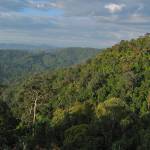Northern New Guinea Swamp Forests
2023 CE • Papua New Guinea
The largely unexplored Northern New Guinea Swamp Forests "represents the lowland, freshwater, and peat swamp forests associated with the great lowland river systems of New Guinea," home to a wide array of wildlife. "Bats rule these forests", such as the Fly River horseshoe bat, and the Fly River trumpet-eared bat. Additionally, 76 species of mammals "inhabit this ecoregion, 13 [of which] are endemic or near-endemic to these forests . . . The highlands of the north coastal ranges harbor Scott’s tree kangaroo, considered to be the largest and most threatened forest mammal native to Papua New Guinea. The ecoregion’s two endemic bird species include Brass’ Friarbird and the pale-billed sicklebill. The raucous calls of large, black palm cockatoos can be heard in the lowland forests and swamps." Despite its immense biodiversity, rampant deforestation driven by logging operations, agricultural expansion, and palm oil plantations, along with illegal hunting and climate change, jeopardize the delicate balance of this swamp forest ecosystem.
Quote: "Northern New Guinea lowland rain and freshwater swamp forests (AA0115)," Wild World Ecoregion Profile, 2001.
David Olson, "Northern New Guinea Lowland Rain and Freshwater Swamp Forests," One Earth.
Image: eGuide Travel, CC BY 2.0, via Wikimedia Commons


Learn about Maya Lin’s fifth and final memorial: a multi-platform science based artwork that presents an ecological history of our world - past, present, and future.

Discover ecological histories and stories of former abundance, loss, and recovery on the map of memory.

Learn how we can reduce our emissions and protect and restore species and habitats – around the world.

See how art can help us rethink the problems we face, and give us hope that each one of us can make a difference.

Help make a global memorial something personal and close to home. Share your stories of the natural world.


